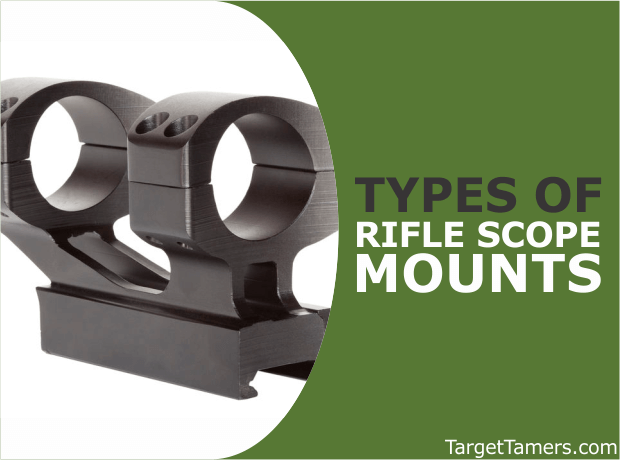
The mount is just as important as the rifle scope and can be just as pricey.
When you’re already spending more than a few hundred dollars on your scope and must tack on another hundred or so for the mount, the out-the-door price doesn’t seem so friendly anymore.
What mount do you currently have?
Will it work with your new scope or must you start from scratch?
Do you want a quick detach mount for convenience or one that intends to hold zero with heavy and repeated recoil?
Whatever your reasons are for polishing up on rifle scope mounts, you’ll know more than a thing or two about ‘em by the end.
Types of Rifle Scope Mounting Rails
Typically, when you hear the term “base,” most are referring to the lower connection part between the rifle and the scope. This is undoubtedly the rail.
While some manufacturers may have their own proprietary rails that will only work with their brand-specific mounts, the standard rails are the Picatinny and Weaver. These days, the rail will already come installed on the rifle.
You’ll need to determine what type of rail it is to appropriately pair it with the right mount since this is one rifle scope accessory you can't go without!
Picatinny Rails
- MIL-STD 1913 aka Picatinny
- 0.206” wide slots
- Standardized distances between slots (0.394” center-to-center)
- Wider and deeper slots
- Slots may extend down the rail
- Compatible with all Picatinny mounts
- Mini versions built-in on handguns as an accessory rail
Weaver Rails
- Predates the Picatinny
- 0.180” wide slots
- Ununiform slot distances between Weaver rails
- Slot distances are narrower than Picatinny
- May have less slots
- Original 2-piece design that frees up obstruction of the bolt opening
- May require extension base
- Weaver mounts may be compatible for mounting to Picatinny rail
- Tends to offer low-profile mounting
Dovetail Rails
- Aka “Tip-off” mount
- Dovetail design
- 3/8” and 11mm most common dovetail sizes
- Not as oft-used as Picatinny or Weaver
- Popular on rimfire and air rifles
- Easy to mount optics due to dovetail slide mounting
Types of Riflescope Mounts
The truth is most people are excited about the new rifle scope they’re buying and don’t give a second thought to the mount.
This is especially true if you’re paying someone else to mount the new scope to your rifle, and the pairing of it to an appropriate mount goes unseen and unappreciated by you.
For those who are set up and are capable of mounting their own systems, you’ll know that you either must match the scope to the mount or you’re in for a whole new mounting system that could include a new rail! It’s best to match the scope to your mount and budget or expect for this while you’re searching for a new scope.
Since there are many different types of mounts, you should brush up on mount types and which rifle scope mount is best for you.
Picatinny Mounts
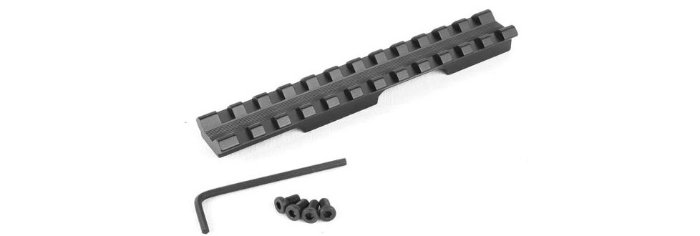
The Picatinny mount is perhaps the most popular type of mounting system for scopes because it has universal, standardized measurements. Due to this, many manufacturers make accessories to fit any Picatinny mount. While Weaver accessories can fit Picatinny rails, there is some play in the fitting.
Some mounting systems include recoil keys to prevent the scope from moving during recoil. The idea is to push the rings up towards the muzzle so that during recoil, the scope does not move in place.
One major advantage of Picatinny mounts is that you usually have multiple slots and an extended length to place scope rings where desired to achieve the best scope mounting setup.
You can also use 20 MOA bases with Picatinny rails to get more elevation adjustment travel for long-range shooting.
Weaver Mounts
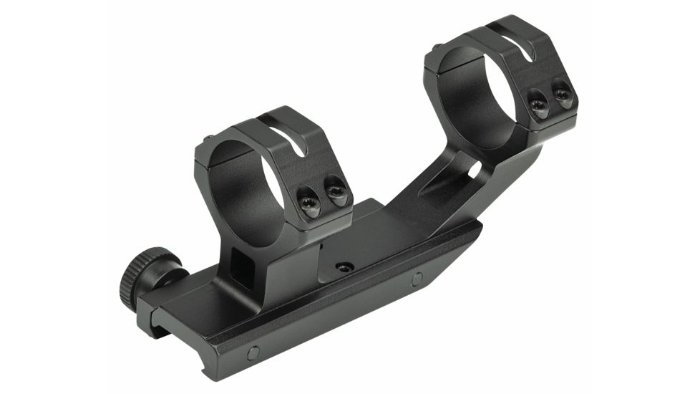
Like Picatinny mounts, the ring size on any complete Weaver mount will need to match the scope tube width, i.e. 1”, 30mm, 34mm, etc., and rings are secured around the tube and then secured to the rail at the base.
It’s best to match Weaver-to-Weaver systems as the wider Picatinny accessories will not fit the narrower Weaver bases unless you’re willing to Dremel the slots – definitely not ideal or recommended for the amateur.
They can come in one-piece and two-piece rails. The problem is that slot widths on Weaver rails are not uniform from one Weaver rail to the next which means it won’t be compatible with all Weaver accessories. Generally, manufacturers trying to stick to commonly accepted specs will provide a Weaver rail with .180” wide lugs and 7/8” slot widths.
Dovetail Mounts
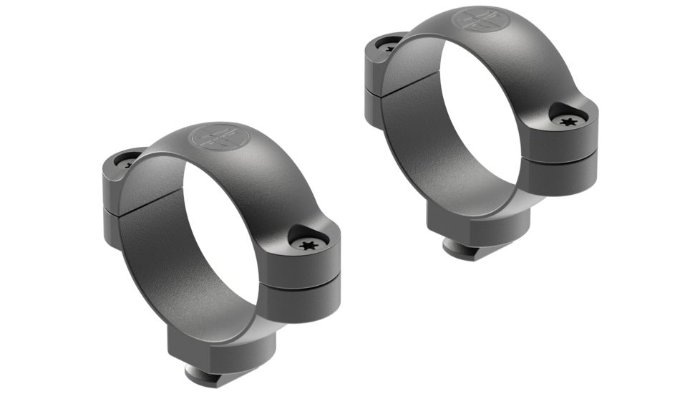
Obviously, dovetail rings are best suited to dovetail mounts. Dovetail rings are also called tip-off rings due to the ability to tip them off the dovetail rail when screws are loosened instead of having to slide them all the way off. Though, not all dovetail rings allow for this amount of play to tip them off.
Of course, the ring size should be specific to the tube size of your scope and the ring base must match the dovetail size of the dovetail rail.
Single-Piece Mounts
Single-piece or one-piece mounts are easy to work with because they’re robust, tough, and generally easy to mount. Some may require use with a rail.
The major benefit is that there isn’t much thinking about aligning the scope, aligning the rings, etc. The one-piece mount has done that for you.
The one-piece includes the base that connects to the rifle with the appropriate securing mechanisms and the rings. Due to its one-piece construction and resulting maximum rigidity, they’re popular for high-recoil calibers.
However, they’re less popular on bolt action rifles because they may obstruct bolt action. Some one-piece mounts have a cut-out that clears the chamber allowing for easier access. They tend to be heavy mounting systems due to the complete assembly.
Two-Piece Mounts
Essentially, you’re mounting two, separate rings directly to itsy-bitsy two-piece rails. These are incredibly convenient for bolt action rifles as there is no obstruction to working the bolt and the chamber.
If you have big hands, fat fingers, wear gloves, want unobstructed access to clear jams, reload cartridges, etc., the two-piece mount must be considered.
Obviously, they’re lighter in weight than one-piece mounts but they’re tricker to install because the rings must be correctly aligned.
Integral Mounts
Integral mounts tend to be rifle scope manufacturer specific as the mount itself is designed into the rifle scope to be attached directly to the rail or the receiver. This mounting system bypasses rings and other components.
However, other types of integral mounts are similar to one-piece mounts where it’s a complete assembly with rings and a base made specifically for that receiver.
Others consist of only the rings that attach directly to the receiver of a specific rifle. Rifles compatible with integral ring mounts already have the bases machined into the receiver.
Offset/Cantilever Mounts
Offset mounts, also called cantilever mounts, are exactly what they sound like – offset. They’re like a one-piece with rings and a base that attaches to a Picatinny rail designed mostly for AR-style platforms. However, the overall design can vary from one model to another.
The rings are designed to be far forward of the actual mounting length to allow for room between the eyepiece of the scope and the shooter’s brow. This includes popular offset sizes of 2” and 3”.
This not only provides proper eye relief to see the full field of view, but also to protect the shooter from scope bite and allows for iron sights to be used as a backup if needed.
Some offset mounts also allow for moving the scope closer to your eye to acquire good eye relief. It depends on the engineering of the mount as to how versatile it can be.
20 MOA Base Mount
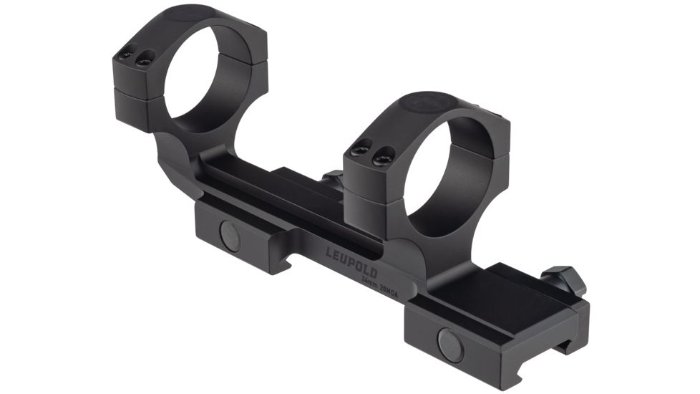
A 20 MOA base is compatible with Picatinny accessories. This makes it extremely versatile for those who have Picatinny accessories and need extra elevation adjustment for long-range shooting. Other bases are 0 MOA meaning that they are level with the bore of the rifle.
Without getting into the specifics of when gaining the extra 20 MOA is beneficial or not and what defines long range, it should suffice to say that a 20 MOA base will gain you some extra dialing for those longer shots.
The base itself is canted which means it allows for the scope be pointed slightly downwards towards the barrel. While sounding counterproductive to those new to this concept, it is actually correct in achieving more elevation adjustment.
Quick Release Mounts
There are all sorts of quick release mounting styles from complete one-piece assemblies to quick release rings. Usually, these types of mounts have a throw lever-type release mechanism that allows for tool-less removal and remounting of the scope.
The idea is to first provide convenience of mounting/dismounting when you’re using the same weapon for multiple optics. A legitimate concern is whether or not you can retain your zero after dismounting and then remounting the optic.
Since the scope is not removed from the mount, rather the mount from the rail, zero retention should not be affected provided it gets placed exactly into position (between the slots on the rail) to where it was zeroed. Of course, quality quick detach mounts will make a difference to this effect.
FAQs
While similar in appearance and identical in purpose, they’re very different mounting systems. The Picatinny mount has wider, standardized slot measurements for attaching mostly Picatinny accessories with some reasonable acceptance of Weaver accessories.
Weaver mounts do not have standardized measurements, slots are narrower, and are only compatible with Weaver accessories.
Ideally, Picatinny and Weaver mounts should not be interchangeable. It doesn’t mean that it can’t be done, but it is far from ideal to mix and match mounting and accessory combinations.
Picatinny rails have wider slots, though uniform and standardized whereas Weaver rails do not and are narrower.
While you can rig a Weaver mount to a Picatinny base, there will be some play in the fittings because the slots are wider on the Picatinny. However, you cannot fit a Picatinny mount to a Weaver rail because the slots are too narrow to accept the Picatinny base. Those who want to force this issue can Dremel or file the rail to allow for acceptance of Picatinny accessories.
Yes and no. Most mounts are generally universal in specs for pairing with either a Picatinny or Weaver rail. This requires you to know what type mount you want with or without certain features that will fit the rifle scope and what rail is currently on your rifle.
The no part comes in with rifle scope manufacturers that have their own non-industry-standard mount specifications that match their rifle scope’s specs and design. So, even though they’re designed to either attach to a Weaver or Picatinny rail, the rifle scope may only be compatible with the manufacturer mount.
Your Mount is Either the Weak or Strong Link
The mount is responsible for holding the scope to the weapon. As you can see, it also contributes to rifle scope accuracy, long-range performance, achieving proper eye relief, access to working the bolt, zero retention, and more.
While the mount itself is small, choosing the right rings or mount is no small matter.
Your choice of mount can either be the weak link in the equation or the strong link in your rifle scope setup.
One more thing to keep in mind - some rings will require lapping to achieve optimal contact between the scope and the rings. Learn how to lap scope rings here.
Further Reading
- Wire vs Glass Etched Reticles: Which Should You Choose for Your Rifle Scope?
- What Is Your Best Hunting Gear Investment? 25 Expert Hunters Weigh In
- What is the Sight Picture & Sight Alignment? [WITH PICS]
- What Is The Difference Between Reflex Sights VS Red Dot? Find Out Here!
- What Is MOA? Calculating Minutes of Angle & Making Turret Adjustments









Have a BSA S4 x 32 WR, having a hell of a time with a rail that it will mount on. Using it for a Ruger 10/22